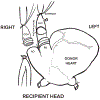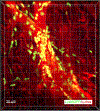Mouse Heterotopic Cervical Cardiac Transplantation Utilizing Vascular Cuffs
- PMID: 35815977
- PMCID: PMC9779923
- DOI: 10.3791/64089
Mouse Heterotopic Cervical Cardiac Transplantation Utilizing Vascular Cuffs
Abstract
Murine models of cardiac transplantation are frequently utilized to study ischemia-reperfusion injury, innate and adaptive immune responses after transplantation, and the impact of immunomodulatory therapies on graft rejection. Heterotopic cervical heart transplantation in mice was first described in 1991 using sutured anastomoses and subsequently modified to include cuff techniques. This modification allowed for improved success rates, and since then, there have been multiple reports that have proposed further technical improvements. However, translation into more widespread utilization remains limited due to the technical difficulty associated with graft anastomoses, which requires precision to achieve adequate length and caliber of the cuffs to avoid vascular anastomotic twisting or excessive tension, which can result in damage to the graft. The present protocol describes a modified technique for performing heterotopic cervical cardiac transplantation in mice which involves cuff placement on the recipient's common carotid artery and the donor's pulmonary artery in alignment with the direction of the blood flow.
Figures



References
-
- Abbott CP, Lindsey ES, Creech O Jr., Dewitt CW A technique for heart transplantation in the rat. The Archives of Surgery. 89, 645–652 (1964). - PubMed
-
- Ono K, Lindsey ES Improved technique of heart transplantation in rats. The Journal of Thoracic and Cardiovascular Surgery. 57 (2), 225–229 (1969). - PubMed
-
- Corry RJ, Winn HJ, Russell PS Heart transplantation in congenic strains of mice. Transplantation Proceedings. 5 (1), 733–735 (1973). - PubMed
-
- Heron I. A technique for accessory cervical heart transplantation in rabbits and rats. Acta Pathologica Microbiologica Scandinavica Section A Pathology. 79 (4), 366–372 (1971). - PubMed
-
- Chen ZH A technique of cervical heterotopic heart transplantation in mice. Transplantation. 52 (6), 1099–1101 (1991). - PubMed
Publication types
MeSH terms
Grants and funding
LinkOut - more resources
Full Text Sources
Medical
